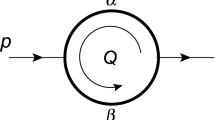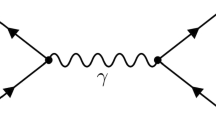Abstract
We consider cubature formulae which are invariant with respect to a transformation group and prove sufficient conditions for such formulae to have positive weights. This is worked out for different symmetries: we consider central symmetric, symmetric and fully symmetric cubature formulae. The theoretical results are illustrated with examples.
Similar content being viewed by others
References
R. Cools and A. Haegemans,Construction of fully symmetric cubature formulae of degree 4k — 3for fully symmetric planar regions, Report TW 71, K. U. Leuven (1985).
R. Cools and A. Haegemans,Construction of fully symmetric cubature formulae of degree 4k — 3for fully symmetric planar regions, Journal C. A. M. 17 (1987), 173–180.
R. Cools and A. Haegemans,Construction of symmetric cubature formulae with the number of knots (almost) equal to Möller's lower bound, Report TW 97, K. U. Leuven (1987).
P. J. Davis,Interpolation and Approximation, Blaisdell N.Y. (1963).
D. A. Dunavant,Economical symmetrical quadrature rules for complete polynomials over a square domain, Int. J. Num. Meth. Eng. 21 (1985), 1777–1784.
A. Haegemans and R. Piessens,Construction of cubature formulas of degree eleven for symmetric planar regions, using orthogonal polynomials, Numer. Math. 25 (1976), 139–148.
A. Haegemans and R. Piessens,Construction of cubature formulas of degree seven and nine for symmetric planar regions, using orthogonal polynomials, SIAM J. Numer. Anal. 14 (1977), 492–508.
F. Mantel,Rectangular symmetric multidimensional cubature structures, The Weizmann Institute of Science, Rehovot, Israel (1978).
H. M. Möller,Polynomideale und Kubaturformeln, Dissertation, Universität Dortmund (1973).
H. M. Möller, Kubaturformeln mit minimaler Knotenzahl, Numer. Math. 25 (1976), 185–200.
I. P. Mysovskin,On the construction of cubature formulas with fewest nodes, Soviet Math. Dokl. 9 (1968), 277–280.
S. L. Sobolev,Formulas of mechanical cubature on the surface of a sphere (in Russ.), Sibirsk. Mat. Z. 3 (1962), 769–796.
A. H. Stroud,Approximate Calculation of Multiple Integrals, Prentice Hall, Englewood Cliffs, N.Y. (1971).
Author information
Authors and Affiliations
Rights and permissions
About this article
Cite this article
Cools, R., Haegemans, A. Why do so many cubature formulae have so many positive weights?. BIT 28, 791–802 (1988). https://doi.org/10.1007/BF01954899
Received:
Revised:
Issue Date:
DOI: https://doi.org/10.1007/BF01954899




